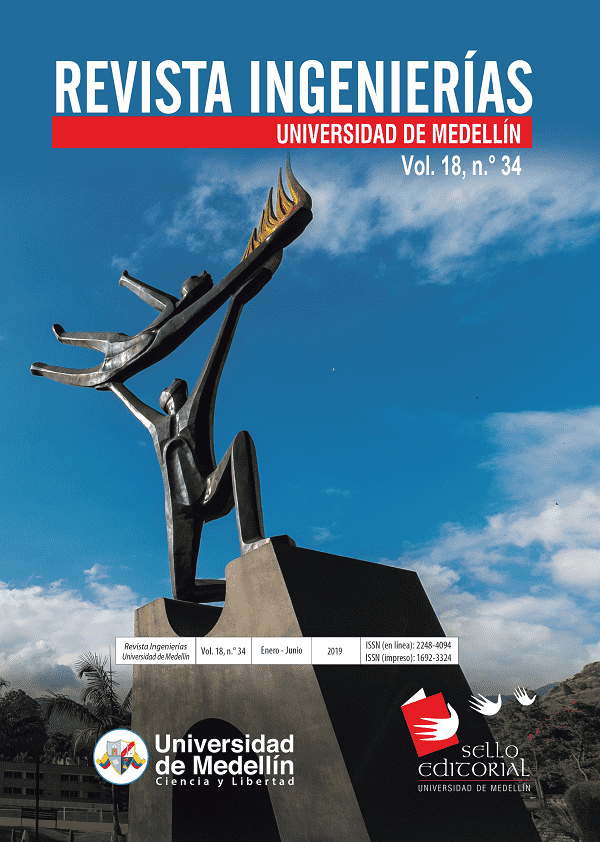Bandwidth optimization in BPL power lines using nucleolus and max-min fairness techniques
Main Article Content
Abstract
BPL power lines (Broadband Power Line) run under the HomePlug AV (HPAV) standard which uses the technologies CSMA/CA and TDMA as a mechanism of access to the medium, in which CSMA/CA is intended for the transmission of data packets and TDMA is used for the transmission of voice and video packets, in order to offer adequate levels of QoS. However, notwithstanding that the HPAV can reach high transfer rates, it lacks the adequate bandwidth (AB) allocation mechanism, which in turn interferes significantly with the network’s performance as the number of users rise due to the fact that only one node can transmit at once. In line with the raised above and taking into account that a BPL network can be represented as a cooperative game with transferable utilities (UT), the present paper proposes the use of two equitable bandwidth allocation techniques: nucleolus and max-min fairness, which are part of the cooperative game theory. In the comparison of the nucleolus y max-min fairness techniques as an strategy for resource allocation it was found that the latter produces the best results. Furthermore, it was made evident that game theory can be regarded as a groundbreaking strategy for the optimization of resources in a LAN network on BPL.
Article Details
References
[1] N. Anatory y J. Theethayi, Broadband Power-Line Communication Systems: Theory and Applications, Londres: WIT Press, 2010.
[2] H. Latchman et al., Homeplug AV and IEEE 1901: A Handbook for PLC Designers and Users, Nueva Jersey: Wiley-IEEE Press, 2013.
[3] S. Goldfisher y S. Tanabe, 'IEEE 1901 access system: An overview of its uniqueness and motivation,' IEEE Commun. Mag., vol. 48, n.° 10, pp. 150-157, Oct. 2010.
[4] S. Galli et al., 'For the Grid and Through the Grid: The Role of Power Line Communications in the Smart Grid,' Proc. IEEE, vol. 99, n.° 6, pp. 998-1027, 2011.
[5] E. V. Rogozhnikov et al., 'Full-duplex power line communication system. Analog cancellation, system concept and implementation problems,' presentado en 2018 Moscow Workshop on Electronic and Networking Technologies (MWENT), pp. 1-5, 2018.
[6] A. Mengi et al., 'The ITU-T G.9960 broadband PLC communication concept for smartgrid applications,' presentado en 2017 IEEE International Conference on Smart Grid Communications (SmartGridComm), pp. 492-496, Dresden, 2017.
[7] J. Pérez et al., Teoría de juegos, Madrid: Pearson-Prentice Hall, 2003.
[8] M. Seijo et al., 'Planning and Performance Challenges in Power Line Communications Networks for Smart Grids,' Int. J. Distrib. Sens. Networks, vol. 12, n.° 3, pp. 1-17, 2016.
[9] B. Peleg y P. Sudhölter, Introduction to the theory of cooperative games, Berlín: Springer, 2007.
[10] A. Loni y F.A. Parand, 'A survey of game theory approach in smart grid with emphasis on cooperative games,' presentado en 2017 IEEE International Conference on Smart Grid and Smart Cities (ICSGSC), 2017, pp. 237-242, Dresden, 2017.
[11] M. Hajir et al., 'Solidarity-based cooperative games for resource allocation with macro-users protection in HetNets,' presentado en 2016 IEEE International Conference on Communications (ICC), pp. 1-7, Kuala Lumpur, 2016.
[12] P. Berens, 'CircStat: a MATLAB toolbox for circular statistics,' J. Stat. Softw., vol.31, n.° 10, pp. 1-21, 2009.
[13] X. Huang y B. Bensaou, 'On max-min fairness and scheduling in wireless ad-hoc networks: analytical framework and implementation,' presentado en Proc. 2nd ACM Int. Symp. Mob. ad hoc Netw. Comput., Long Beach, 2001.
[14] Y. Sheng y M. H. MacGregor, 'Dynamic Resource Allocation Based on Weighted Max-Min Fairness,' presentado en Communication Networks and Services Research Conference (CNSR), 2011 Ninth Annual, pp. 247-256, Ottawa, 2011.
[15] E. L. Hahne, 'Round-robin scheduling for max-min fairness in data networks,' IEEE J. Sel. Areas Commun., vol. 9, n.° 7, pp. 1024-1039, 1991.
[16] J. Chen et al., 'A local fairness algorithm for the MetaRing, and its performance study,' presentado en [Conference Record] GLOBECOM ’92 - Communications for Global Users: IEEE, pp. 1635-1641, Orlando, 1992.
[17] J. S.-C. Chen, et al., 'A local fairness algorithm for gigabit LAN’s/MAN’s with spatial reuse,' IEEE J. Sel. Areas Commun., vol. 11, n° 8, pp. 1183-1192, 1993.
[18] D. Schmeidler, 'The Nucleolus of a Characteristic Function Game.' SIAM J. Appl. Math., vol. 17, n.° 6, pp. 1163-1170, 1969.
[19] I. Curiel, Cooperative game theory and applications: cooperative games arising from combinatorial optimization problem, Dordrecht: Kluwer Academic Publishers, 1997.
[20] D. Nace et al., 'A tutorial on max-min fairness and its applications to routing, load-balancing and network design,' presentado en 4th IEEE Int. Conf. Comput. Sci. Res. Innov. Vis. Futur., p. 30, Santa Bárbara, 2006.
[21] F. Canete, 'User guide for PLC channel generator v.2,' Septiembre 2011. [En Línea]. Disponible: http://www.plc.uma.es/channel_generator/User_guide_v2.pdf
[22] P. J. Pinero-Escuer et al., ' Homeplug-AV C SMA/CA C ross-Layer E xtension for Q oS Improvement of Multimedia Services,' IEEE Commun. Lett., vol. 18, n.° 4, pp. 704-707, 2014.
[23] R. Walpole et al., Probabilidad y estadística para ingenieros. Ciudad de México: Pearson-Prentice Hall, 2007.





